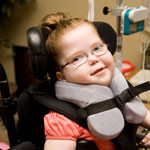Study Finds Cerebral Palsy Inherited Risk
 A new study has found that the risks of having a child with cerebral palsy (CP) are higher in families in which one or more relatives already has the condition. Cerebral palsy is a neurologically based disability affecting gross motor, speech and other functions on a spectrum of mild to severe. Researchers in Norway have now found that the condition, which often presents as problems in pregnancy and complications at birth, is more apt to reoccur in families.
A new study has found that the risks of having a child with cerebral palsy (CP) are higher in families in which one or more relatives already has the condition. Cerebral palsy is a neurologically based disability affecting gross motor, speech and other functions on a spectrum of mild to severe. Researchers in Norway have now found that the condition, which often presents as problems in pregnancy and complications at birth, is more apt to reoccur in families.
New Norway study sheds light on causes of cerebral palsy
Authors of the study Mette C. Tollanes, Allen J. Wilcox, Roly T. Lie and Dag Moster utilized Norway’s Medical Birth Registry to study children with cerebral palsy, their connections and lineage from as early as 1967 up until 2002. Was and is CP hereditary, and if so, how? That was the question the researchers sought to answer. Their findings appeared last month in the online British Medical Journal.
Based on their findings, the authors concluded the following: “People born into families in which someone already has cerebral palsy are themselves at elevated risk, depending on their degree of relatedness. Elevated risk may extend even to third degree relatives (first cousins). The patterns of risk suggest multifactorial inheritance, in which multiple genes interact with each other and with environmental factors. These data offer additional evidence that the underlying causes of cerebral palsy extend beyond the clinical management of delivery.”
In other words, risks for cerebral palsy are higher in families where a relation has cerebral palsy—though that risk will remain overall quite negligible, according to the study.
Study findings—details, implications
In statistical terms, risks of giving birth to a child with cerebral palsy are minimal: of the some 2.03 million persons born between 1967 and 2002, only 3,649 received a diagnosis of CP, researchers found. Nonetheless, researchers also found that parents affected by CP face somewhere between six to nine times the risk of having a child with CP—and that the level of risk does not change even when pre-term births are taken out of the calculations.
For other CP-affected relatives, the risks of having a child with CP are not quite so high as they are for the affected parents of a child with CP. So, for example, a half sibling faces almost three times the risk and an affected first cousin 1.5 times the risk.
Until the results of this study, there was little in the way of concrete evidence to back up a long-held suspicion that CP is genetically inherited.
Twins at alarmingly higher risk for children with CP
The new study only reinforces previous evidence around twins, finding that the twin of a child with CP was more than 15 times likelier to have a child with the condition.
Cerebral palsy affects around two in every 1,000 births.
If the condition does in fact have certain genetic markers, in the way of inheritable DNA that can be identified, there is still much ground to be covered in finding them, researchers have cautioned.
To this day, CP can be linked to a number of causes. These can include: events in pregnancy or delivery, such as premature birth, infections, dietary deficiencies, lack of oxygen to the brain, and injuries resulting from doctor error or other form of medical malpractice.
The Norway study’s findings will help expectant mothers at greater risk for having children with CP, and their providers, exercise better-informed, cautious prenatal care decisions.


